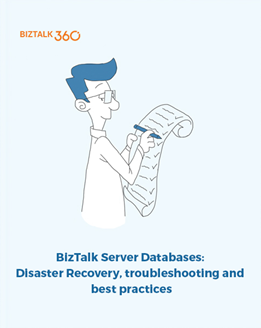Finally, BizTalk Server Databases: Disaster Recovery, Troubleshooting and Best Practices whitepaper is published! I think this was my crazy project ever because I started during an MVP Summit, probably in 2013 with a very basic whitepaper of 7 pages about Disaster Recovery and my initial review was Tord Glad Nordahl… for some reason I never finished or published the content and last year again during the MVP Summit I revived this idea and basically annoyed all the MVPs that were next to me that day to review the initial document again… bad idea for me because, probably to get revenge on me, they were the most demanding reviewers that I ever had, always asking for more content making, therefore, the whitepaper more complete. So, what was a 7-pages whitepaper becomes a 34-pages whitepaper.
What to expect about BizTalk Server Databases: Disaster Recovery, Troubleshooting and Best Practices whitepaper
Microsoft BizTalk Server databases and the health of the databases are very important for a successful BizTalk Server messaging environment. BizTalk Server is an extremely database-intensive platform, persisting data to disk with high frequency, and one of the main reasons for that is because one of the primary design goals of BizTalk Server is to ensure that no messages are lost. Therefore, database performance is paramount to the overall performance of any BizTalk Server solution.
There are many factors that you need to take into consideration towards troubleshooting, maintaining, monitoring or recovering from disasters. This paper will provide you some important aspects to consider when working with BizTalk Server databases and addressing the most common and important aspects:
- Size of databases and tables: performance degrades on High Size of BizTalk databases
- Important consideration to avoid large BizTalk Databases
- Separation of data files and log files (SQL Server disk I/O contention)
- Important consideration BizTalk SQL Settings
- Available tools for monitoring and troubleshooting
- Recovering from disasters situations (Clean up your BizTalk databases)
However, the content is very valuable with regards to even preventing a disaster or limit the probability of it. After reading this paper you should be prepared for any disaster but also to preventing for happening because be able to prevent is better than resolving.
Where I can download it
You can download the whitepaper here:
 BizTalk Server Databases: Disaster Recovery, Troubleshooting and Best Practices (1.14 MB)
BizTalk Server Databases: Disaster Recovery, Troubleshooting and Best Practices (1.14 MB)
BizTalk360
I would like to take this opportunity also to say thanks to my amazing reviewers: Steef-Jan Wiggers, Nino Crudele, Kent Weare, Mikael Hakansson and Salvatore Pellitteri for taking the time to review this whitepaper. And other people that were involved in making this “project” came true like Tord Glad Nordahl, Lex Hegt, Saravana Kumar and Sriram Hariharan.
I hope you enjoy reading this paper and any comments or suggestions are welcome.


